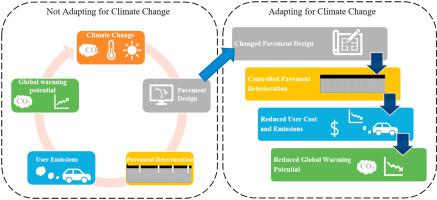Journal of Cleaner Production ( IF 11.1 ) Pub Date : 2022-08-08 , DOI: 10.1016/j.jclepro.2022.133355 Surya Teja Swarna , Kamal Hossain , Alyssa Bernier

|
Presently, there is strong consensus that significant temperature and weather changes are fast approaching as a result of climate change. Pavements will be significantly affected by increased temperatures, precipitation, and flooding, and will require present design methodology to be modified accordingly. Several climate change adaptation strategies are easily available to agencies including upgraded asphalt binder grades, increased Hot Mix Asphalt (HMA) thickness, modified mix gradations, and stabilized base. The objective of this study is to investigate Life Cycle Assessment (LCA) and Life Cycle Cost Analysis (LCCA) for climate change adaptation strategies across various locations in Canada, from a Global Warming Potential (GWP) perspective. All analysis was completed leveraging the Athena Pavement LCA software and the LTPP database. The investigated scenarios were (i) a baseline asphalt pavement with no climate change, (ii) a baseline asphalt pavement with climate change, and (iii) an asphalt pavement adapted to withstand climate change, appropriate to the level of changes experienced by the specific location. The study revealed that although there are initial increases in both cost and emission to administer these adaptation strategies, they are offset over the life of the pavements. Increasing the HMA thickness and using stabilized bases were the most expensive and the highest emitting among the investigated strategies, but they are only necessary for extreme coastal climate change regions including British Columbia and Newfoundland. British Columbia is expected to observe a near 30% increase in agency costs to effectively adapt their pavements to climate change. However, these initiatives were found to decrease the overall global warming potential by nearly 10% in comparison to not adapting. The other examined locations, although not returning as drastic of changes, followed similar trends. The conclusions find that climate change adaptation strategies are highly beneficial from the standpoint of both an LCA and LCCA for all of the investigated locations.
中文翻译:

加拿大沥青路面的气候变化适应战略;第 2 部分:生命周期评估和生命周期成本分析
目前,人们普遍认为,由于气候变化,显着的温度和天气变化正在迅速逼近。路面将受到温度升高、降水和洪水的显着影响,并且需要相应地修改现有的设计方法。一些气候变化适应策略很容易被机构使用,包括升级沥青粘合剂等级、增加热拌沥青 (HMA) 厚度、改进混合等级和稳定基层。本研究的目的是调查生命周期评估(LCA) 和生命周期成本分析(LCCA) 从全球变暖潜能值 (GWP) 的角度来看,加拿大各地的气候变化适应战略。所有分析均利用 Athena Pavement LCA 软件和 LTPP 数据库完成。调查的情景是(i)基线没有气候变化的沥青路面,(ii) 有气候变化的基线沥青路面,和 (iii) 适应气候变化的沥青路面,适合特定位置所经历的变化水平。研究表明,尽管管理这些适应策略的成本和排放量最初都增加了,但它们在路面的使用寿命中被抵消了。在所研究的策略中,增加 HMA 厚度和使用稳定的碱基是最昂贵和最高排放的,但它们仅对包括不列颠哥伦比亚省和纽芬兰在内的极端沿海气候变化地区是必要的。预计不列颠哥伦比亚省的代理成本将增加近 30%,以有效调整其路面以适应气候变化。然而,与不适应这些举措相比,这些举措被发现可以将全球整体变暖潜能值降低近 10%。其他检查的地点虽然没有恢复剧烈的变化,但也遵循了类似的趋势。结论发现,从 LCA 和 LCCA 的角度来看,气候变化适应策略对所有调查地点都非常有益。



























 京公网安备 11010802027423号
京公网安备 11010802027423号